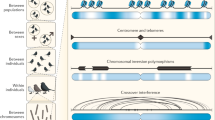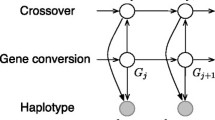Summary
Estimates of allelic recombination frequencies are shown to have coefficients of variation of between 20 and 40%. In Coprinus this is true of both high and low recombination frequencies and is also true when the alleles involved show marker effect. This variability is not confined to Coprinus but is a general feature of both meiotic and mitotic allelic recombination. Experimental errors do not make a major contribution to the observed variation althought it has the nature of a sampling variation. It is suggested that the variation arises from the diversity of ways in which the initial errors introduced by hybrid DNA formation can be resolved during the excision-repair stages of recombination. If the enzymes responsible for these processes are present in low concentrations then much latitude can be anticipated in the way the same errors are dealt with by separate, though isogenic, diploid or dikaryotic organisms. Each separate cross is thus interpreted as providing an estimate of the recombination frequency which is but a sample from a varied population of possible estimates of the same recombination frequency. Each pair of alleles exhibits a recombination frequency which, within the statistical boundaries of the general variation, is sufficiently reproducible to be described as a characteristic of them. Combinations of allelic recombination frequencies derived from pair-wise crosses fall into patterns that are sufficiently consistent for allele maps to be drawn; and, providing a sufficient number of replicate crosses have been analysed, the allele map can be shown to be statistically soundly based. Two marker effect situations are examined. One causes reduction of recombination frequency and is probably intrinsic to the mutant site itself, the other causes enhancement of recombination frequency and is due to a factor or factors distinct from the allelic mutant site in the strain in which it was first identified. When intercrossed the two effects counteract one another.
Similar content being viewed by others
References
Case, M.E., Giles, N.H.: Allelic recombination in Neurospora. Tetrad analysis of a three-point cross within the pan-2 locus. Genetics 49, 529–540 (1964)
Catcheside, D.G.: Occurrence in wild strains of Neurospora crassa of genes controlling genetic recombination. Aust. J. biol. Sci. 28, 213–225 (1975)
Day, A.W., Wellman, A.M., Martin, J.: Recombination in Ustilago violacea after liquid nitrogen refrigeration. Canad. J. Microbiol. 18, 1639–1641 (1972)
Fogel, S., Mortimer, R.K.: Informational transfer in meiotic gene conversion. Proc. nat. Acad. Sci (Wash.) 62, 96–103 (1969)
Hastings, P.J.: Some aspects of recombination in eukaryotic organisms. Ann. Rev. Genet. 9, 129–144 (1975)
Holliday, R.: A mechanism for gene conversion in fungi. Genet. Res. 5, 282–304 (1964)
Ipsen, J., Jerne, N.K.: Graphic evaluation of the distribution of small experimental series. Acta path. microbiol. scand. 21, 343–361 (1944)
Jessop, A.P., Catcheside, D.G.: Interallelic recombination at the his-1 locus in Neurospora crassa and its genetic control. Heredity 20, 237–256 (1965)
Kitani, Y., Olive, L.S.: Genetics of Sordaria fimicola. VI. Gene conversion at the g locus in mutantxwild type crosses. Genetics 57, 767–782 (1967)
Leblon, G.: Mechanism of gene conversion in Ascobolus immersus. I. Existence of a correlation between the origin of the mutants induced by different mutagens and their conversion spectrum. Molec. gen. Genet. 115, 36–48 (1972a)
Leblon, G.: Mechanism of gene conversion in Ascobolus immersus. II. The relationship between the genetic alterations in b 1 or b 2 mutants and their conversion spectrum. Molec. gen. Genet. 116, 322–335 (1972b)
Leblon, G., Rossignol, J.-L.: Mechanism of gene conversion in Ascobolus immersus. III. The interaction of heteroalleles in the conversion process. Molec. gen. Genet. 122, 165–182 (1973)
Millington-Ward, A.M.: Recombination and transcription in the hisB and paba1 loci of Aspergillus nidulans. Genetica 41, 557–574 (1970)
Moore, C.W., Sherman, F.: Role of DNA sequences in genetic recombination in the iso-1-cytochrome c gene of yeast. 1. Discrepancies between physical distances and genetic distances determined by five mapping procedures. Genetics 79, 397–418 (1975)
Moore, D.: Sources of carbon and energy used by Coprinus lagopus sensu Buller. J. gen. Microbiol. 58, 49–56 (1969)
Moore, D.: Genetic fine structure site clustering and marker effect in the ftr cistron of Coprinus. Genet. Res. 19, 281–303 (1972)
Moore, D.: Variability of recombination frequencies in the ftr cistron of Coprinus and its influence on the identification of marker effect alleles. Genet. Res. 22, 187–193 (1973a)
Moore, D.: Mutants of Coprinus selected for resistance to D-glucosamine and L-sorbose. Genet. Res. 22, 205–209 (1973b)
Moore, D.: Dynamic unwinding of DNA helices: a mechanism for genetic recombination. J. theor. Biol. 43, 167–186, (1974)
Moore, D.: Distribution of alleles of diverse mutagenic origins in the allele map of the ftr cistron. Mutation Res. 28, 455–458 (1975)
Moore, D., Devadatham, M.S.: Distribution of mutant sites in the ftr cistron depends upon the medium used for selection. Molec. gen. Genet. 138, 81–84 (1975)
Moore, D., Stewart, G.R.: Mutants of Coprinus lagopus selected for resistance to 2-deoxy-D-glucose. Genet. Res. 18, 341–352 (1971)
Murray, N.E.: Polarized recombination and fine structure within the me-2 gene of Neurospora crassa. Genetics 48, 1163–1183 (1963)
Pateman, J.A.: High negative interference at the am locus in Neurospora crassa. Genetics 45, 839–846 (1960)
Radford, A.: Variability of recombination within the pyridoxine locus of Neurospora. Cand. J. Genet. Cytol. 10, 444–447 (1968)
Snedecor, G.W., Cochran, W.G.: Statistical methods. 6th edit. Ames, Iowa: Iowa State University Press 1967
Spudich, J.L., Koshland, D.E.: Non-genetic individuality: chance in the single cell. Nature (Lond.) 262, 467–471 (1976)
Tessman, I.: Genetic ultrafine structure in the T4 rII region. Genetic 51, 63–75 (1965)
Whitehouse, H.L.K., Hastings, P.J.: The analysis of genetic recombination on the polaron hybrid DNA model. Genet. Res. 6, 27–92 (1965)
Author information
Authors and Affiliations
Additional information
Communicated by F. Kaudewitz
Rights and permissions
About this article
Cite this article
Moore, D., Katy, N.S.O. Variability of allelic recombination frequencies. Molec. Gen. Genet. 159, 311–320 (1978). https://doi.org/10.1007/BF00268268
Received:
Issue Date:
DOI: https://doi.org/10.1007/BF00268268




